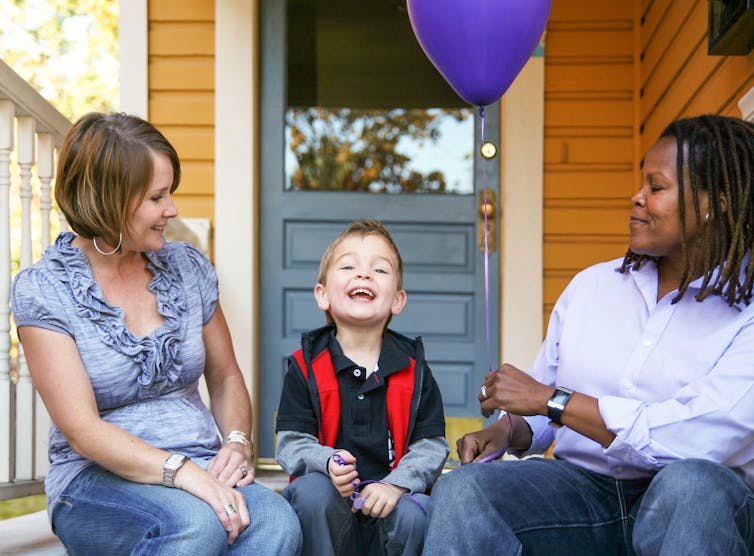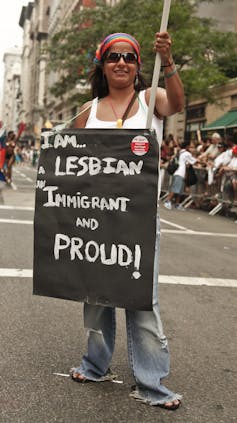When you hear the word immigrant or newcomer, what image does that evoke? Do you instinctively picture a racialized person? A foreign-born entrepreneur? Or a man and a woman with their children?
There is more to the Canadian immigration narrative than this. It is not just the Canadian public with these ideas. According to my recent study, lesbian, gay, bisexual, transgender and queer (LGBTQ) immigrants are generally not imagined by policymakers and settlement providers either.
When they are paid attention to, it is often in response to a humanitarian crisis, such as the targeting of suspected and self-identified gay and bisexual men in Chechnya in 2017. At the time of the “gay purge,” the Canadian government was instrumental in secretly bringing more than a dozen men to safety in Canada.
Seen as exceptions
Yet, in general, it becomes hard to imagine cases of LGBTQ immigrants in any other way but as exceptions.
In my two-stage study, which I worked on with Ontario-based scholar Ferzana Chaze, I looked into immigrant-serving organizations in Ontario and Newfoundland and Labrador to see if they demonstrated an awareness of racially diverse LGBTQ immigrants. I also wanted to find out where the welcoming spaces for these newcomers exist.
Were there differences in the welcome provided by settlement service organizations in these two provinces? What types of services do organizations that identify as LGBTQ positive spaces offer to this group of newcomers?
An organization’s website is the first point of contact for many newcomers because it provides a comprehensive overview of the services provided. Therefore, we decided to do a content analysis of the outreach websites as the first stage of our study.

The government of Ontario provides a comprehensive list of settlement service organizations, from which we randomly chose 33 Ontario organizations that worked primarily in newcomer settlement and had a website in English.
Compared to Ontario, Newfoundland and Labrador attracts far fewer newcomers. Only one (federally funded) organization provided such services to all newcomers, irrespective of race/ethnicity or gender. We included this organization in the study.
We considered factors such as LGBTQ-friendly images; images of racially diverse LGBTQ people; and specific programming for LGBTQ newcomers. We also identified whether the organization website listed inclusion policies specific to LGBTQ immigrants; whether the website had information in languages other than English or French; and whether the website provided links or references to LGBTQ community resources.
Findings not encouraging

Our findings were not encouraging. Only four organizations (12 per cent) had LGBTQ-positive imagery or text displayed on their websites. Three organizations (nine per cent) explicitly mentioned services for LGBTQ immigrants. Two organizations (six per cent) displayed images that clearly represented racially diverse LGBTQ immigrants; only four (12 per cent) had links to resources that might be useful to LGBTQ immigrants.
In the second stage of our study, we narrowed our research to nine settlement service organizations, self-identified as LGBTQ positive spaces, that offered programs and services specifically to LGBTQ immigrants.
While some of these organizations provided LGBTQ supportive services only to specific subgroups of immigrants (e.g., youth or persons with intellectual disabilities), others had a range of informational and support services for all LGBTQ newcomers. Some of these services include counselling, community building, health and well-being programs, networking and education.
Canada, a leader in LGBTQ rights
Canada has an international reputation as a leader in LGBTQ rights and for the most part, we agree with this characterization. Compared to other parts of the world, where LGBTQ people live in precarious and sometimes deadly environments, the human rights of LGBTQ people are protected in this country.
A recent example is Bill C-16, which updated the Canadian Human Rights Act and the Criminal Code in 2017. The new law made it illegal for anyone to discriminate against transgender people on the basis of their gender identity or expression.
This landmark legislation was a significant step in ensuring equality for transgender people, sending a powerful message that they are an integral part of Canada’s social fabric.
Given such legislative and social advances, the Canadian settlement organizations in our study were not as welcoming of LGBTQ immigrants as one would expect. We found heteronormative assumptions embedded within immigration and settlement policies and practices.
Regardless of these organization’s intentions, the message being conveyed to LGBTQ immigrants is that they are not welcome or they do not matter. This message of insignificance is antithetical to the larger narrative of Canada as a refuge for LGBTQ people.
Our research indicates that settlement organizations operate from a heterosexist approach. Given this, they may not be able to acknowledge the needs of their diverse service users, including LGBTQ immigrants.
Better support needed
Representation thus matters. We we also believe it is important for LGBTQ immigrants to see themselves reflected in the policies and practices of settlement organizations so that they feel supported during this major life transition.
Based on our research, we recommend simple things that could make a big difference. For example, making an organization’s website accessible in languages other than English and French could go a long way to helping non-native-English-speaking LGBTQ immigrants gain knowledge about the services available to them.
Only 25 per cent of the settlement organizations we surveyed had the option to view the website in languages other than English. Settlement organizations should neither assume nor expect the cultural communities to which LGBTQ immigrants belong to fill this gap. To do so risks exposing LGBTQ immigrants to negative heterosexist attitudes and behaviours from those in their own cultural communities.

Differences in terms of racial and ethnic diversity are also important to consider. It may be less challenging for LGBTQ immigrants in provinces with greater racial and ethnic diversity to make connections with others from their cultural communities for help with settlement needs.
These connections are less likely to occur in a predominantly white province like Newfoundland and Labrador. This puts a greater emphasis on the only federally funded settlement organization there to assist LGBTQ immigrants of colour with adjusting to their new life.
A commitment to success for all
The lack of recognition of LGBTQ immigrants can lead to a lack of ability to support them through the settlement and integration process.
Inclusion and diversity policies are an important means by which organizations express their commitment to identifying and addressing barriers that can get in the way of people reaching their full potential.
But in our study, LGBTQ immigrants were largely absent from the inclusion and diversity policies of the settlement organizations. In addition to signalling the erasure of LGBTQ immigrants from awareness, the exclusion upholds the conventional view of immigration as a heterosexual project, which overlooks nonheterosexual orientation and the gendered experiences of migration.
Reversing this situation will require that settlement organizations prioritize LGBTQ immigrants in their work, first by recognizing them as an important component of immigration to Canada, and then by working collaboratively with them and local LGBTQ community groups to meet their needs.
When organizations are attuned to the diversity of their service users, the success of LGBTQ immigrant integration in Ontario and Newfoundland and Labrador may be furthered. With such attunement, settlement organizations can develop programs and services, and make greater investment and commitment to that success.
The author thanks his co-author and co-investigator, Ferzana Chaze, for her contribution to this article.

